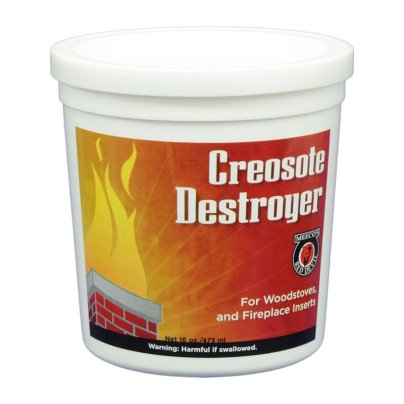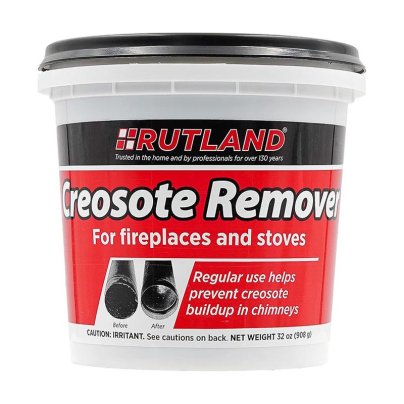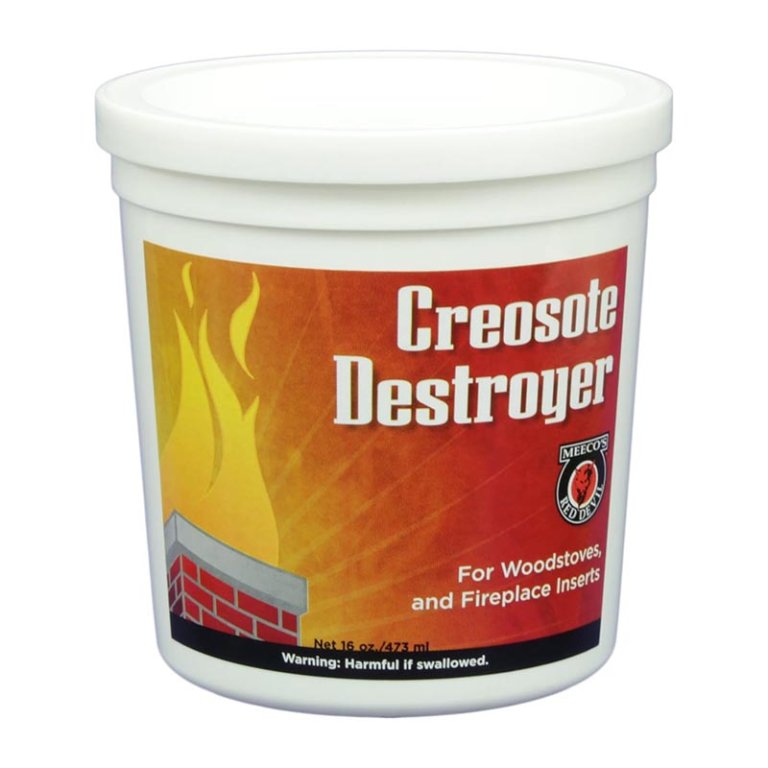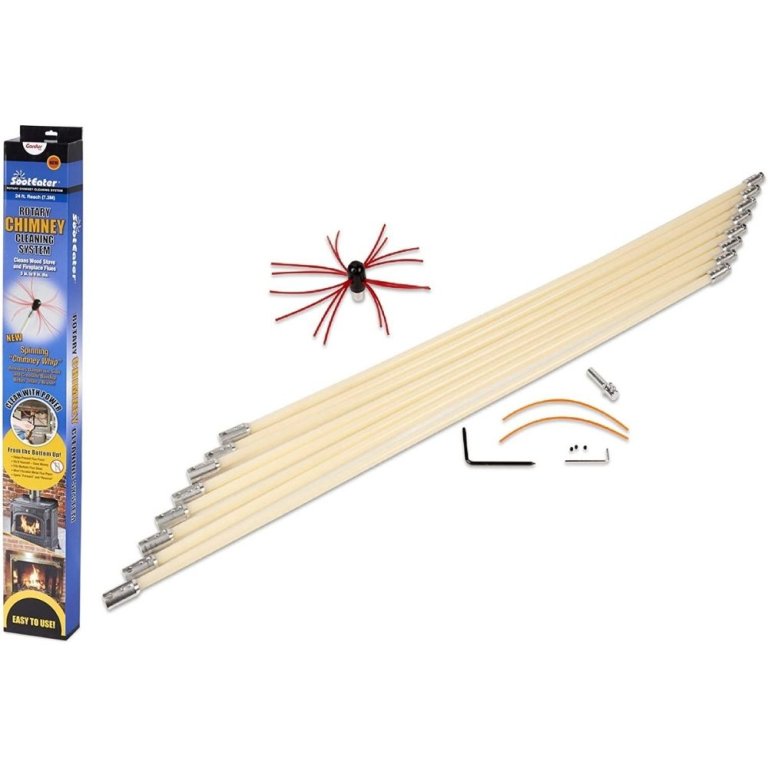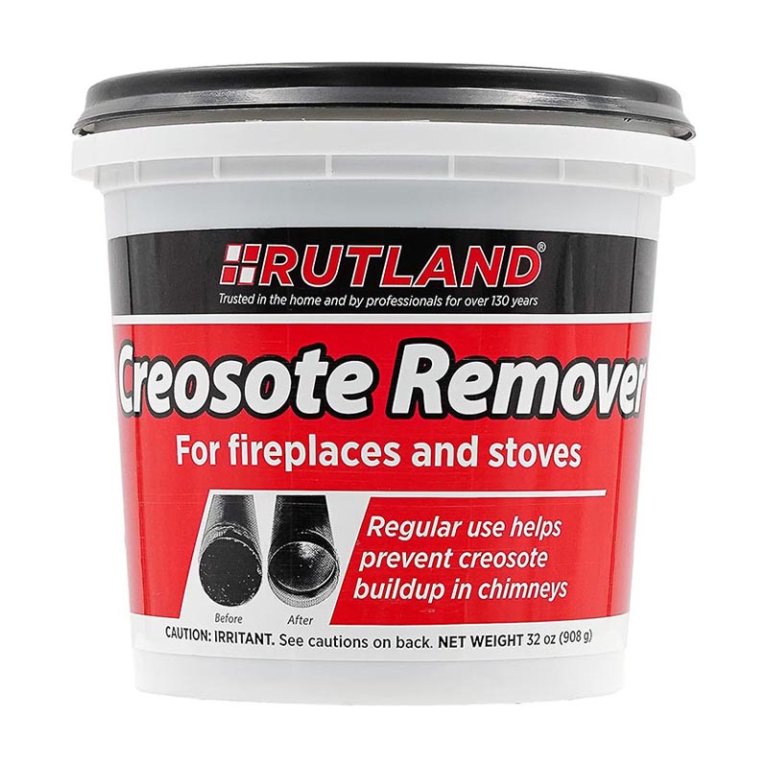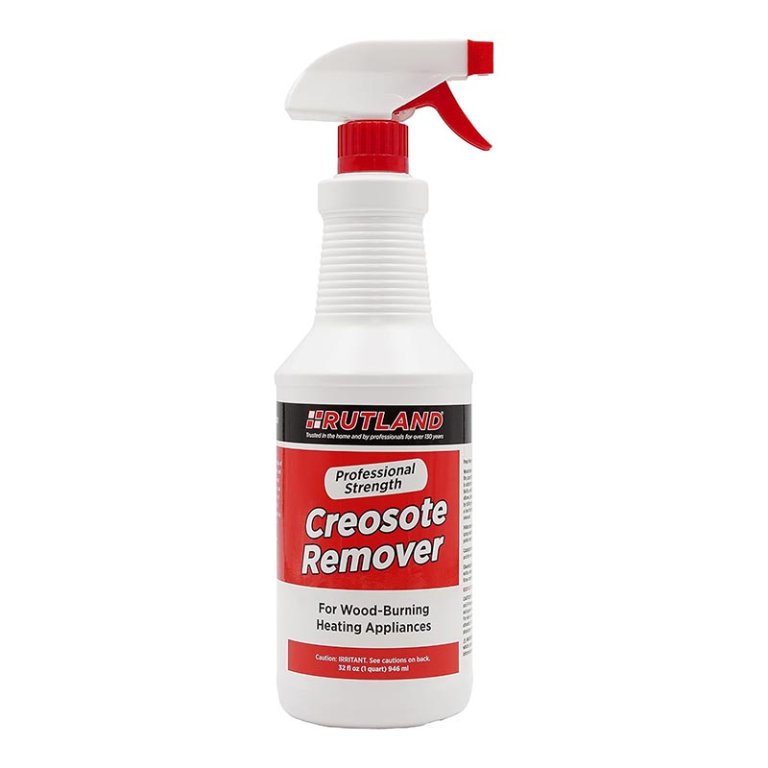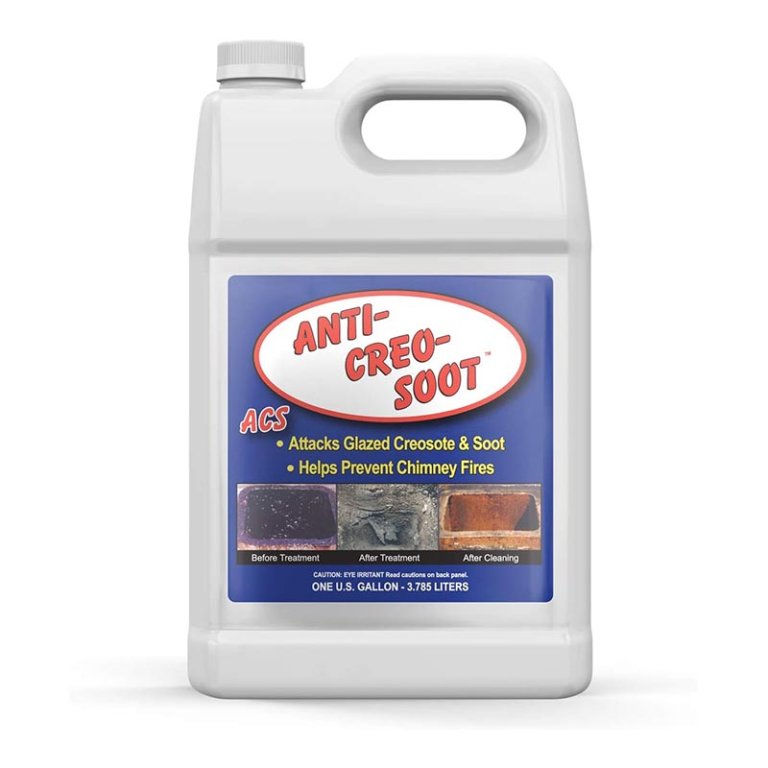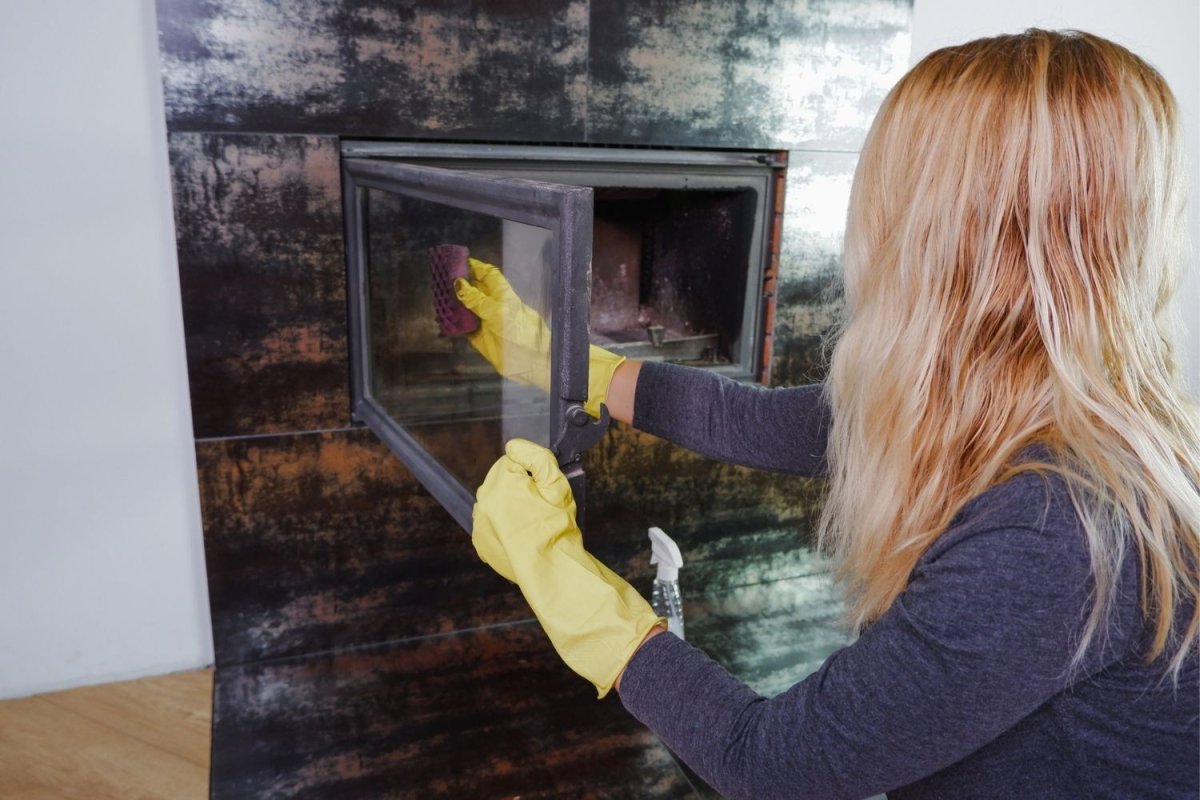
We may earn revenue from the products available on this page and participate in affiliate programs. Learn More ›
It’s crucial to remove creosote in a chimney with a specially formulated creosote remover before it becomes problematic and, even worse, dangerous. Creosote is a byproduct of burning wood, coal, pellets, or oil, which create gases as they burn. These gases rise through the chimney, coating the inside of the chimney liner as they do. Today’s fireplaces are designed to allow maximum airflow, which reduces creosote buildup, but still, this design doesn’t completely eliminate the issue.
Having a chimney professionally cleaned is one method to remove creosote, but it isn’t the only way. Handy individuals can clean the chimney themselves if they have the right tools, and a variety of creosote-dissolving products are available to help. We spoke to Tim Smith, owner of Actual Chimney Specialists in Averill Park, New York, who says that creosote removers should be a part of anyone’s wood-burning habits: “It is a sure way to manage creosote when you are unaware of what is happening inside of your chimney throughout the season.” He adds that “new wood-burning appliances are much better at burning clean and efficient, which reduces creosote production.” Even so, he recommends having a chimney professional inspect the chimney before the season so you can determine what’s the best option and product for your situation.
The best creosote remover for cleaning a chimney will vary based on the amount of buildup and the cleaning method necessary to remove the accumulation. Our favorite is Meeco’s Red Devil Creosote Destroyer for its ease of use and effectiveness. Ahead, learn why creosote buildup can be detrimental, explore several of the factors to consider when purchasing creosote remover, and discover some more of the best creosote removers on the market to keep your chimney clean and safe.
- BEST OVERALL: Meeco’s Red Devil 2-Pound Creosote Destroyer
↓ Jump to Review - RUNNER-UP: Gardus SLK-24 SootEater Chimney Whip Brush
↓ Jump to Review - BEST BANG FOR THE BUCK: Rutland Products 2-Pound Creosote Remover
↓ Jump to Review - BEST LOG: Pine Mountain First Alert Creosote Buster
↓ Jump to Review - BEST SPRAY: Rutland Products Liquid Creosote Remover
↓ Jump to Review - BEST FOR MILD CREOSOTE: Quick N Brite Fireplace Cleaner With Cleaning Brush
↓ Jump to Review - BEST FOR GLAZED CREOSOTE: ACS Anti-Creo-Soot Liquid Creosote Remover
↓ Jump to Review
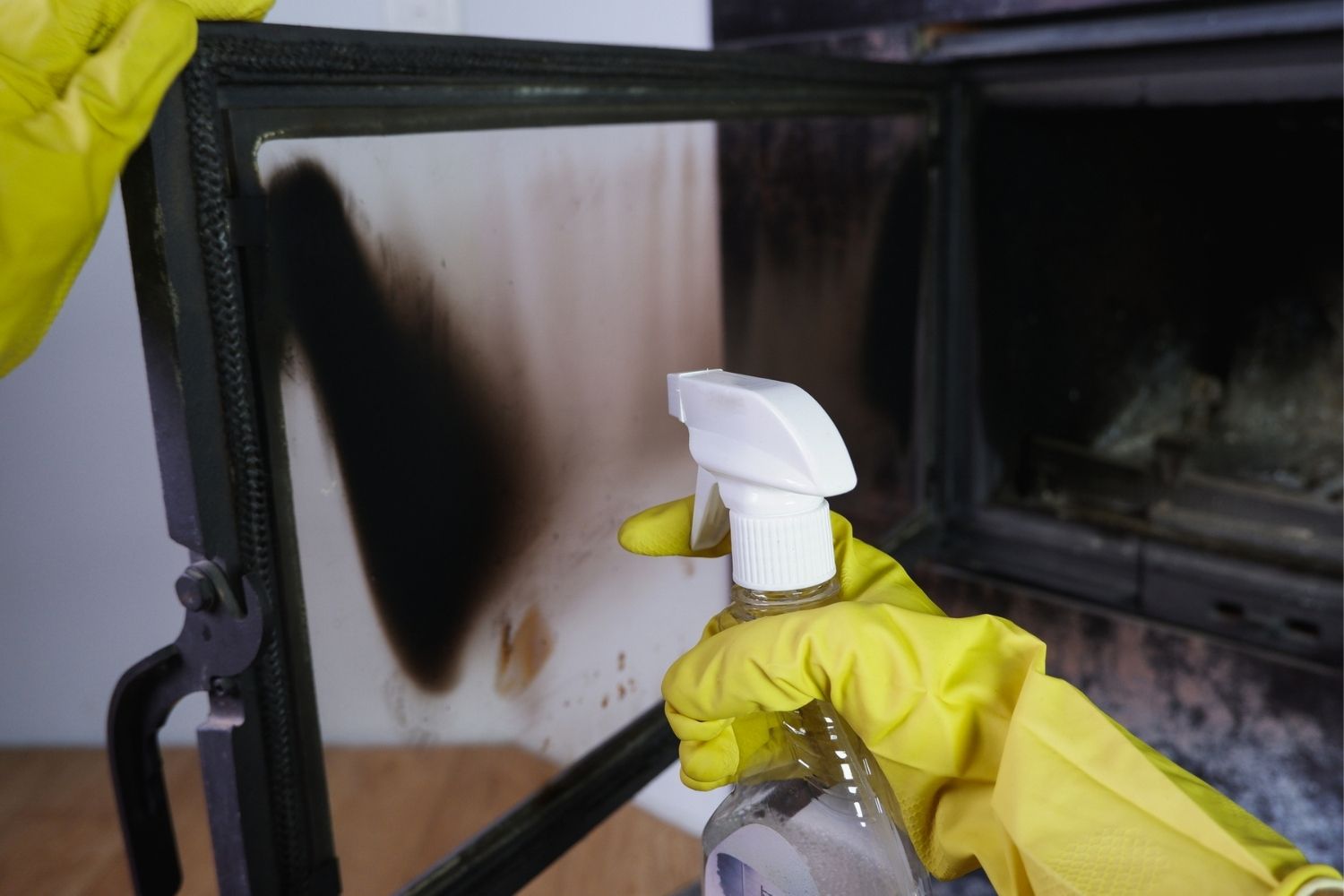
Our Top Picks
A good creosote remover should be relatively simple to use. The product should treat the appropriate degree of creosote buildup and help the user to maintain a clean chimney. The following products represent some of the best creosote removers on the market, featuring different types designed for the various degrees of creosote buildup. When using any chimney creosote remover that contains chemicals, always carefully follow the manufacturer’s application and safety instructions.
Best Overall
Meeco’s Red Devil 2-Pound Creosote Destroyer
What We Like
- Fast and easy to use
- 2-pound container is a good value
- Destroys binder that that holds creosote particles together
What We Don’t Like
- Some users say lid did not come securely attached to tub
Product Specs
- Type: Powder
- Works on: Woodstoves, fireplace inserts
- Frequency of use: Every third fire or every other day if using 24/7
Preventing creosote from building up in a chimney liner and removing existing creosote can be as simple as sprinkling a few teaspoons of Meeco’s Red Devil Creosote Destroyer over firewood or coal every third time a fire is lit in the fireplace. As the fire burns, the remover’s chemicals—which include copper chloride, silicon dioxide, and fixed carbon—coat the chimney liner and keep creosote residue from adhering while also breaking down any existing buildup.
This creosote powder comes in a 2-pound tub, enough for 16 applications. Keep in mind that it is not intended to remove thick, hardened creosote deposits.
Get the Meeco’s Red Devil creosote remover at Amazon, Menards, or Hartville Hardware & Lumber.
Runner-up
Gardus SLK-24 SootEater Chimney Whip Brush
What We Like
- Cleans up to 24-foot chimneys
- Fits through tight areas
- Won’t scratch metal liners
- Cleans 5- to 9-inch-diameter flues
What We Don’t Like
- Requires more elbow grease than other products that are simply applied to creosote
Product Specs
- Type: Manual; whip head
- Works on: Wood-burning fireplace chimneys, wood-burning stove flues
- Frequency of use: When soot and creosote accumulations are ¼ inch or more
No need to climb up onto the roof to remove creosote with the Gardus SootEater Rotary chimney whip brush. Designed to clean wood-burning fireplace chimneys and wood-burning stove flues, this system includes eight 3-foot, flexible quick-connect rods; a whip head; and a drill adapter. The user attaches the whip head to the top of a quick-connect rod and then joins the other end, via the adapter, to a standard drill.
When the drill is turned on, the whip head, which features strong 12 millimeter nylon strings, spins (like a weed eater) and removes creosote buildup from inside the flue or liner. The additional connect rods can be attached as needed to reach higher in the chimney, and since each one is flexible, it’s possible to clean around bends in a flue.
Get the Gardus creosote remover at Lowe’s, Tractor Supply Co., or The Home Depot.
Best Bang for the Buck
Rutland Products 2-Pound Creosote Remover
What We Like
- Fast and easy to use
- Can be applied to first- or second-degree creosote
- Heat activated at 265 degrees Fahrenheit
What We Don’t Like
- Few complaints, but some users have issues with quality control
Product Specs
- Type: Powder
- Works on: All chimneys and wood-burning appliances
- Frequency of use: Apply 1-ounce scoop 1 to 2 times per week
For an inexpensive way to remove creosote from a chimney or flue, consider Rutland Products’ 2-pound tub of powdered creosote remover. It’s like a smaller version of the Best Overall pick, containing enough remover to treat a wood-burning fireplace or wood-burning stove 16 times; simply sprinkle a 1-ounce scoop to a bed of hot coals one to two times per week.
The heat from a fire releases the active ingredients, which then penetrate first- or second-degree creosote. This remover dissolves the sticky, tarlike residue and turns it into powdery ash that falls harmlessly to the bottom of the firebox.
Get the Rutland Products powder creosote remover at Amazon, Tractor Supply Co., The Home Depot, or Rutland.
Best Log
Pine Mountain First Alert Creosote Buster
What We Like
- More environmentally friendly than other products
- Extremely easy to use
- Only needed once per season or every 40 fires; good value
What We Don’t Like
- Doesn’t work on heavy creosote accumulation
Product Specs
- Type: Fire log
- Works on: Wood-burning stoves and fireplaces
- Frequency of use: Add log once per season or every 40 fires
One of the simplest ways to prevent creosote buildup is with a creosote sweeping log, such as the First Alert Creosote Buster from Pine Mountain. Simply remove the outer wrapping and then place the fire log atop already-burning logs in the fireplace. The log contains heat-released chemicals that become airborne and seek out first- and second-degree creosote in the chimney liner. These chemicals then penetrate soot and residue and break it down, leaving it to dry and fall to the firebox where it can be swept away. The manufacturer recommends adding a sweeping log to the fireplace once per season or, if the fireplace is used frequently, once every 40 fires.
Made from renewable resources, the log is also an environmentally friendly choice for fighting creosote buildup. It produces up to 75 percent less particulate matter and 80 percent less carbon monoxide than common types of firewood.
Get the Pine Mountain creosote remover at Amazon (2-pack) or Walmart (1-pack).
Best Spray
Rutland Products Rutland Liquid Creosote Remover
What We Like
- Safe for everyday use
- Perfect for pellet stoves
- Works on first- and second-degree creosote buildup
What We Don’t Like
- Some buyers complain of a defective sprayer
Product Specs
- Type: Liquid
- Works on: All stove and flue types, but especially pellet stoves
- Frequency of use: Once per week
For pellet stove users, Rutland Products liquid creosote remover spray is an optimal treatment that requires spraying the liquid on the pellets before loading them into the stove’s hopper. As the pellets burn, the chemicals release, and the gases penetrate first- and second-degree creosote buildup. The creosote dissolves and dries out, so it falls from the flue and into the bottom of the firebox.
This 32-ounce bottle of spray remover is also suitable for wood stoves and wood fireplaces, where users can spray it directly onto the logs. For the best results, treat pellets or wood once per week to help keep flues and chimney liners clear.
Get the Rutland Products liquid creosote remover at Amazon, The Home Depot, or Rutland.
Best for Mild Creosote
Quick N Brite Fireplace Cleaner With Cleaning Brush
What We Like
- Plant-based and fragrance-free; eco-friendly
- Heavy duty yet nonabrasive
- No need to wear a mask or gloves when using
- Includes a scrub brush
What We Don’t Like
- Does not remove all stains
Product Specs
- Type: Gel
- Works on: Brick, stone, tile, rock, and marble
- Frequency of use: N/A
Creosote buildup isn’t always limited to the inside of a chimney liner or flue. If a fireplace is not a newer, airtight model, it’s common for fires to emit tiny amounts of soot along the outside of the firebox, leading to dark stains on brick or stone fireplace surrounds and mantels. This sooty creosote residue can be challenging to remove with regular household cleaners, but Quick N Brite fireplace cleaner helps dissolve the residue to make the fireplace look fresh and new.
The 16-ounce bottle of gel concentrate is biodegradable, nontoxic, and environmentally friendly, making it safe for people, pets, and the planet. Apply it to areas with stains and buildup with a wet scrub sponge, then rinse with water and wipe with a cloth. For even heavier residue, the included scrub brush can be used as well.
Get the Quick N Brite creosote remover at Amazon, Walmart, or Quick N Brite.
Best for Glazed Creosote
ACS Anti-Creo-Soot Liquid Creosote Remover
What We Like
- Nontoxic and easy to use
- Good value for the money
- Very effective
What We Don’t Like
- Does not include a spray bottle
Product Specs
- Type: Liquid
- Works on: Wood and coal stoves, pellet stoves, fireplaces, furnaces, boilers
- Frequency of use: Daily use during heating season
Soften glazed creosote and reduce the risk of chimney fires with the Anti-Creo-Soot liquid creosote remover from ACS. This potent anti-creosote spray should be sprayed daily in the firebox, over the wood, and upward in the flue (sprayer not included). It works to break down hardened, glazed creosote deposits in preparation for a professional chimney sweep to clean.
This nontoxic liquid should be applied at least 7 days in a row before scheduling a professional cleaning. Once the creosote is removed, continued use of the liquid will help keep deposits from reforming in the chimney or flue. It is suitable for use in wood- or coal-burning stoves and fireplaces as well as pellet stoves.
Get the ACS creosote remover at Amazon (1 gallon), Walmart (1 quart), or SaverSystems (1 gallon).
Jump to Our Top Picks
How We Chose the Best Creosote Removers
We researched the top creosote removers on the market to compose our list. We looked at different types of products (logs, liquids, powders, brushes) so shoppers could choose what works best for them. Whether you’d prefer a method that you only have to think about once per season or a product you can sprinkle on every couple of fires, we found something that will fit the bill. We also searched for products that were eco-friendly and nontoxic for those who are more environmentally conscious. Even though some products are pricier than others, we were focused on finding good value for the money.
What to Consider When Choosing a Creosote Remover
When it comes to how to clean a chimney, the best plan is to take action sooner rather than later. Whether they use chemicals or poles and brushes to eliminate the buildup, creosote removers are most effective when the creosote is at the first- or second-degree stage. After that, it may still be possible for a professional to remove the hardened, glazed buildup, but if the deposits are particularly heavy, the solution may require replacing the chimney liner.
Smith offers some helpful advice about these types of products: “These treatment products will not work very well if the moisture in the firewood is too high.” He says typical firewood should be at 15 to 25 percent moisture content, which will keep the creosote manageable. “If the moisture content is over that, these methods will have a hard time combating the creosote production.” What’s your best move? “Buy your wood the year before so it has a chance to dry a full year. This will ensure you are burning the best way and getting the most heat from your wood. This keeps repairs down and creosote at a minimum.”
Product Type
The various types of creosote removers all work best before creosote develops into a hardened residue on the inside of a flue or chimney liner. However, while they go a long way toward keeping a chimney free from residue, they are not a substitute for professional chimney service. For the best results, have the chimney professionally inspected and cleaned before the colder season arrives. Then, use the following products to keep it clean while enjoying the fireplace:
- Creosote sweeping logs: Resembling fire-starter logs, creosote sweeping logs contain heat-released chemicals that reduce the buildup of soot on a chimney liner. Periodically burn a sweeping log, usually every 30 to 60 fires, as directed on the package. During the first and second degree of creosote buildup, sweeping logs can dry out soot and dissolve sticky residue, causing it to fall to the firebox. It can then be swept up and discarded with the wood ash.
- Liquids: Liquid removers often contain liquid manganese, which breaks down creosote buildup. Liquids are suitable for use on first- and second-degree creosote deposits; they’re especially well suited for pellet stoves, in which the pellets fall through a burner pan. The liquid is squirted or sprayed on the fuel, such as pellets or the wood gathered from a fireplace rack. When the fuel burns, it releases chemicals that penetrate buildup, loosen it, and (if it’s not glazed) turn it to ash. If the creosote is glazed, some types of liquid removers can soften the residue in preparation for professional cleaning.
- Powders: Powdered removers are typically sprinkled over logs in the fireplace. When preparing a chimney with glazed deposits for professional cleaning, the powder may need to be applied multiple times to sufficiently soften and loosen the glazed creosote before a chimney sweep can remove it.
- Manual: This type of creosote remover product features scrapers and brushes, similar to the ones used by professional chimney sweeps to remove creosote. Some DIY-type products allow for cleaning from the bottom of the chimney rather than the top.
What to Know About the Dangers of Creosote
Creosote deposits in a chimney can release toxic gases while a fire is lit below. If the gases back up into the home because the fireplace (or stove) isn’t adequately vented, they can cause health problems, such as headaches, burning eyes, skin rashes, and breathing difficulties.
In addition to health concerns, heavy creosote buildup is highly flammable. It may lead to chimney fires that can catch a roof or other parts of a house on fire. In addition to removing the creosote, remember that it’s important to always keep a fire extinguisher near the fireplace or stove. When neglected, creosote buildup is also corrosive and can eat through steel chimney liners and flues.
Degrees of Creosote
It’s essential to understand and identify the various degrees of creosote buildup in order to select the most effective product and removal method. Various products remove different creosote stages, indicated by degree as determined by the thickness and physical properties of the deposits.
First Degree
First degree is the least dangerous level of creosote buildup. It consists of a loose, sooty film that adheres to the chimney liner, much like a layer of dust. At this stage, the creosote is dry and flaky and can be easily brushed away during fireplace cleaning.
Second Degree
As more creosote deposits stick to the chimney’s liner, the heat from subsequent fires transforms them into a thick, sticky substance that adheres to the liner—this is the second degree of creosote buildup. At this point, chemicals are necessary to dissolve the creosote, and scraping or brushing may be required.
Third Degree
If further neglected, the intense heat from fires can turn sticky creosote deposits into a hardened glaze—third-degree creosote buildup—which is difficult to remove and will likely require a professional chimney sweep. At this point, scorching fires in the fireplace can cause the glazed creosote deposits to melt and drip to the bottom of the firebox. This creates an even greater health and fire hazard. Why? Creosote was once used to treat exterior wood timbers, such as those used to construct railroad tracks, to prevent rotting. Studies suggesting that creosote could be carcinogenic (cancer causing) ended the practice.
FAQs
Creosote is a natural byproduct of a burning fire, but once heavy deposits form, it can be difficult to remove—even for a professional. For those who enjoy wood, coal, or pellet fires, some questions about creosote and creosote remover are common.
It can be. When hot, creosote can release fumes that cause respiratory problems, and contact with bare skin can lead to irritation, redness, or rashes. Some studies also indicate that creosote may be a carcinogen (a cancer-causing agent).
When it comes to what dissolves creosote, yes, creosote removers really do work. However, only use them as recommended and to treat the appropriate degree of creosote buildup.
No, the hotter the fire, the more likely it is to cause creosote.
Burn a creosote log once every 30 to 60 fires, depending on the brand of the log.
Yes, creosote logs will help clean away deposits in a wood-stove flue just as in a wood-burning fireplace.
Smith says that you can’t overuse these treatments; however, he adds that some of the products in the daily treatment types can expose users to cancer-causing chemicals. “Using these chemicals more will put you at health risks, and it may be best to stick to the manufacturer’s recommended application,” he says.
Coal and wood creosote are two different substances. Coal creosote is a thick, oily liquid that is amber to black in color. Wood creosote is a colorless to yellowish greasy liquid. It has a smoky odor.
